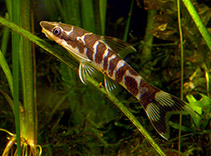| Family: |
Loricariidae (Armored catfishes), subfamily: Hypoptopomatinae |
| Max. size: |
4.38 cm SL (male/unsexed) |
| Environment: |
demersal; freshwater |
| Distribution: |
South America: Peru. |
| Diagnosis: |
Dorsal spines (total): 2-2; Dorsal soft rays (total): 7-7; Anal spines: 1-1; Anal soft rays: 5-5; Vertebrae: 28-28. Can be distinguished from all its congeners by the following putative autapomorphies: unique, distinct color pattern consisting of vertically elongated blotches spanning from the dorsal midline to the ventral border of flanks; complete lateral line, without the gap plates (midbody plates without lateral line perforations) present in other Otocinclus. Can also be differentiated by having high number of teeth (30-45 in premaxilla and 23-36 in dentary). Differs from Otocinclus huaorani, Otocinclus mura and Otocinclus bororo by having a small metapterygoid channel and one W-shaped mark in the caudal fin (Ref. 57860). |
| Biology: |
Found in a medium size creek with clear water and lost of marginal vegetation (Ref. 57860). |
| IUCN Red List Status: |
Endangered (EN); Date assessed: 24 April 2014 (B1ab(v)) Ref. (130435)
|
| Threat to humans: |
harmless |
Source and more info: www.fishbase.org. For personal, classroom, and other internal use only. Not for publication.
